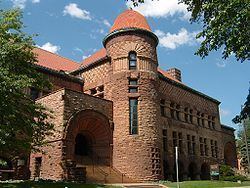NRHP Reference # 84001463 Added to NRHP 23 August 1984 | Built 1886-1907 Area 9 ha | |
 | ||
Architectural style Queen Anne style architecture Similar The Gopher Way, Northrop Field, Coffman Memorial Union | ||
The University of Minnesota Old Campus Historic District, listed on the National Register of Historic Places, includes a number of buildings on the Minneapolis campus that date back to the oldest days of the university.
Contents
Eddy Hall, 1886
Architect: LeRoy BuffingtonOriginally built as the Mechanic Arts building. The Mechanic Arts Building (Eddy Hall, 1886, 1903) is the oldest building within the district, as well as the oldest extant building on the Minneapolis Campus. It was constructed in 1886 according to designs by Minneapolis architect Leroy S. Buffington. Executed in the Queen Anne mode, the building is three stories in height on a high basement; a square tower at the northwest corner dominates the entry. The building is constructed of red brick with red sandstone trim. It is essentially rectangular in plan. Dominant features include the multi-gabled roof, high double-hung windows, panels of patterned brick, and iron cresting and a weather vane on the tower.
Erected at a cost of $30,000, an addition was made to the building in 1903 for an additional $10,000. The building originally housed the mathematics, drawing, civil-municipal-structural engineering departments, as well as testing laboratories. The Mechanic Arts Building has been renamed Eddy Hall in honor of Henry Turned Eddy, former professor of engineering and mathematics and later Dean of the Graduate School.
Pattee Hall, 1889
Architect: J. Walter StevensThe first Law School building, itself founded in 1888. The Law School later moved to Fraser Hall and then to Mondale Hall. It is named after William S. Pattee, the first dean of the law school.
Pillsbury Hall, 1889
Architects: LeRoy Buffington with Harvey EllisOriginally named Science Hall, and named for Governor John S. Pillsbury. Harvey Ellis, Buffington's assistant, was responsible for the Romanesque details in the design. Ellis was inspired by Henry Hobson Richardson, but the building also contains elements of the Prairie School, Arts and Crafts, Gothic, and Victorian styles. The building is built with two different colors of sandstone. The buff-colored sandstone is from quarries near Banning State Park, while the red sandstone is from the Fond du Lac formation. The clay tile roof and copper eaves serve to protect the sandstone from the infiltration of water, and they also add to the appearance of the building. Reflecting its earthen architectural elements, the building is the home of the Newton Horace Winchell School of Earth Sciences.
Nicholson Hall, 1890
Architects: LeRoy Buffington with Harvey EllisBuilt as a chemistry laboratory, until that department moved to Northrop Mall. It served as the men's student union until Coffman Memorial Union was built. The building was recently renovated with $24 million of structural improvements and interior updates, and reopened to the public in January 2006.
Wulling Hall, 1892
Architects: Allen Stem and Charles ReedBuilt as Medical Hall, and later served as the pharmacy building.
Burton Hall, 1894
Architects: LeRoy Buffington and Charles SedgwickThe main library building on campus until Walter Library was built in 1924. Before Burton Hall was built, the library collection was housed in Old Main. A series of fires in Old Main convinced the Board of Regents that a new, fireproof building was needed. President William Watts Folwell first consulted with LeRoy S. Buffington on a library design, but the Regents overruled him. After much debate between the Regents and the faculty, the design was finalized, with the exterior designed by LeRoy S. Buffington in a Greek Revival style and the interior designed by Charles Sedgwick in a rather ornate Victorian style. The building also included an assembly hall which doubled as a chapel.
Armory, 1896
Architect: Charles AldrichBuilt for athletics and for military drills.
Wesbrook Hall, 1898-2011
Architect: Frederick CorserOriginally the Laboratory of Medical Science. It became the home of the dentistry department in 1912, and later served as the location of the Department of Writing Studies. Wesbrook was demolished in August 2011 as part of the Northrop Auditorium renovation project.
Jones Hall, 1901
Architect: Charles AldrichThe first home of the physics department. The building, a Renaissance Revival structure, was renovated in 2005 to provide ADA access and to update building systems. Historic features such as stair treads and banisters, paneled doors, arched ceilings and the terra cotta façade were preserved in the renovation. The building is now home to the Freshman Admissions Welcome Center as well as the College of Liberal Arts language lab.
Child Development, 1903
Architect: Clarence H. Johnston Sr.Originally built as the Mines Building until damaged by fire in 1913. The building was later used for University High School.
Shevlin Hall, 1906
Architect: Ernest KennedyThe site of Old Main, the first building on campus. Shevlin Hall was built as a student union for women until Coffman Memorial Union was built.
Folwell Hall, 1907
Architect: Clarence H. Johnston Sr.Built to house departments that were displaced after Old Main burned in 1904. It is now where the majority of foreign language departments are housed.
Music Education, 1888-2010
Architect: Warren H. HayesOriginally the Student Christian Association building. It once housed the Child Welfare and Music Education departments. On July 8, 2009 the University of Minnesota Board of Regents moved to demolish the building. According to the Regents, the excessive cost of renovation was the main deterrent against any reuse option. The demolition project commenced in May 2010 with an expected cost of $432,000.
